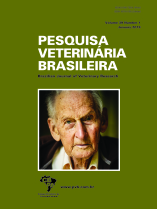 |
|
|
|
Year 2019 - Volume 39, Number 1
|

|
Use of different fixation times and application of two immunohistochemical methods for detection of KIT and Ki67 proteins in canine cutaneous mast cell tumors, 39(1):52-60
|
ABSTRACT.- Santos A., Nascimento H.H.L., Flores M.M. & Kommers G.D. 2019. Use of different fixation times and application of two immunohistochemical methods for detection of KIT and Ki67 proteins in canine cutaneous mast cell tumors. Pesquisa Veterinária Brasileira 39(1):52-60. Laboratório de Patologia Veterinária, Departamento de Patologia, Universidade Federal de Santa Maria, Camobi, Santa Maria, RS 97105-900, Brazil. E-mail: glaukommers@yahoo.com
Due to the high prevalence of mast cell tumors (MCTs) in the diagnostic routine, several factors, especially prognostic, have been sought to determine the biological behavior of these neoplasms. Immunohistochemistry (IHC) is one of the main tools utilized to biologically differentiate more aggressive tumors from less aggressive ones. However, some immunostainings are influenced by formalin fixation, interfering with the results. This is both a retrospective and prospective study of MCTs diagnosed in laboratory routine. A total of 25 samples, without knowledge about fixation time, were analyzed in the retrospective study, whereas 12 samples, with known fixation times, were assessed in the prospective study. Two histologic grading systems (Patnaik and Kiupel), special staining of toluidine blue, and IHC for KIT and Ki67 proteins were applied in both studies. Additionally, two amplification systems (biotinylated and non-biotinylated) for Ki67 protein and counting of the argyrophilic nucleolar organizing regions (AgNOR method) were tested in the prospective study. In the retrospective study, greater agreement between the evaluating pathologists was observed when the Kiupel system was used. IHC staining for KIT protein was effective in both studies, regardless of fixation time. IHC staining for Ki67 protein was highly sensitive to formaldehyde, and staining failure was observed in 56% of the cases in the retrospective study. In the prospective study, samples fixed for longer than 24 hours showed a reduction in the number of stained cells (altering the determination of the cell growth fraction) or showed absence of IHC staining in both amplification systems. The use of the AgNOR method to evaluate the rate of cell proliferation may be an alternative when the fixation time of the neoplasm is unknown or longer than 24 hours. |
| |
|
|
| |
|
 |